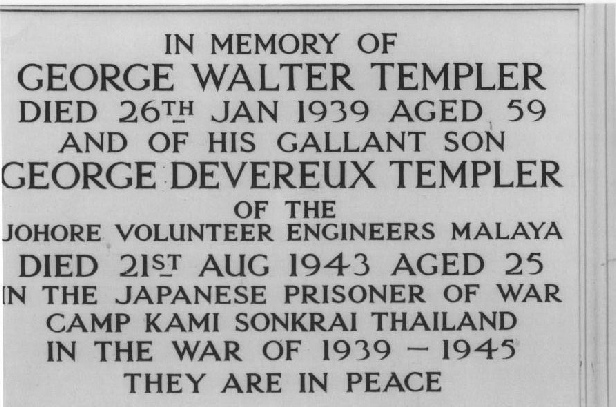
 Conditions
Force F POWs
Conditions
Force F POWs
Field Marshal Sir Gerald Templer
Col James Lethbridge Brooke Templer
Cecil Robert Templer
James Lethbridge Templer
Henry Templer - Mariner
Edward Merson Templer
John Arthur Templer
Harold Edward Templer
James Templer I of Stover
James Templer II of Stover
John Templer of Lindridge
George Templer of Jungpore
Anne de la Pole nee Templer
George Templer of Stover
Henry Line Templer & the Honeychurches
Clause Frank Lethbridge Templer
Balloon Accident
War Ballooning
Military Aviation
The Aldershot Aeronauts
Royal Air Force
Steam Transport it can
Members of the Templer Families
Somerset and Devon Templer Families
Salmon Pool & Stover
Salmon Pool Templer Family
Stover Templer Family
Templer DNA
Leslie Montagu Buller
Arthur Francis Henderson
Philip Templer Furneaux
John Stanley Richardson
Arthur Douglas Richardson
Templer Henry Scott
Henry Bertram Brittan
Edward Guise Brittan
Francis Darvall Templer
Earnest Benbow Richardson
Herbert Cecil Buller
Alan Melville
Edward Foss Prior
Merson Templer Gore-Brett
William Thomas Templer
Eva Graham Prior
Harold Rolleston Brittan
Claude Frank Lethbridge Templer
James Hamilton Spence
Richard Francis Montague Buller
Arthur Edward Adderley Buller*
Walter Evelyn Cramer-Roberts
Raymond De Dibon Richardson
Miles Christian Templer Sargent
Anthony Gordon Peiniger
Graham Templer Swann
John Michael Hewlett Sargent
Denis Henry Dammers
John Edward Templer
Hugh Ranulph Vincent
George Deveraux Templer
Leonard Hugh Acland Harper
Philip Walter Templer
Denzil Templer Branch
Guy Merson Templer
Neville Glyn Williams
Eric William Harington Clarke